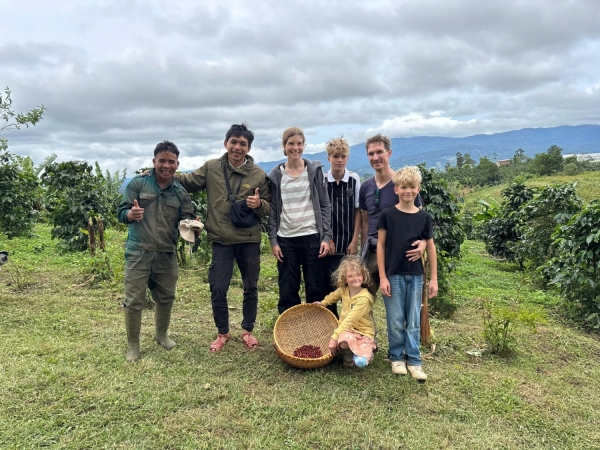
Nếu bạn muốn đọc bài viết này bằng tiếng Việt, vui lòng xem bản chuyển ngữ tại đây: Stone Hill – Tưới Tri Thức, Dẫn Nước Bền Vững Cho Đất Mẹ.
Continuing the story of Stone Hill’s revival under Teacher Phước, today we explore how water management played a critical role in transforming a barren hill into a thriving farm and forest.
Previously, I discussed how soil enrichment prepared the land for cultivation. Now, let's focus on how water solutions made sustainable farming possible.

While organic methods are prioritized, Stone Hill’s model is not entirely organic—some dissolved chemical fertilizers are integrated into drip irrigation for cacao and other crops.
At first, I questioned this approach. But over time, I understood its logic:
✅ Plants need essential nutrients, and they must be supplied efficiently.
✅ Balanced fertilization, when done scientifically, boosts productivity better than relying solely on compost.
Though I also trained in natural pest control for cacao farming, I won’t cover that here—today’s focus is solely on water management strategies.

Water always comes before fertilizer—a principle every farmer understands. At Stone Hill, two main solutions were implemented:
1️⃣ Locating underground water on the hill and redirecting it into reservoirs.
2️⃣ Drilling wells for daily use and storing water for the dry season.
At first, the water supply seemed sufficient, but after years of observation, mountain springs began drying up. To solve this:
This process was not easy, but it laid the foundation for sustainable resource management at Stone Hill.

Since water is limited, drip irrigation was chosen for maximum efficiency. This system offers several advantages:
✅ Precise nutrient distribution – Fertilizers are delivered directly to the roots.
✅ Reduced pests & diseases – Water doesn’t settle on leaves, preventing rot.
✅ Labor & cost savings – A key long-term investment in farm productivity.
Though the concept sounds simple, its practical implementation can be complex. The irrigation system at Stone Hill consists of three key components:
1️⃣ Pumping, filtration & Venturi system – Manages water intake & fertilizer mixing.
2️⃣ Pipeline design – Ensures balanced flow rate, matching pump capacity.
3️⃣ Remote control automation – Allows farmers to irrigate crops from anywhere.
This approach significantly boosts efficiency while conserving water—a method that sets Stone Hill apart in Vietnam’s evolving agricultural landscape.
A step-by-step guide to operating Stone Hill’s drip irrigation and fertilization system. From dissolving specialized fertilizer to adjusting pressure and managing the Venturi injector, this video empowers farmers to take control of nutrient delivery and water efficiency. A hands-on look at smart farming in action.
Stone Hill’s water strategy represents a scientific, structured approach to modern agriculture. Everything is digitalized, driven by plant-specific data to ensure precision & efficiency.
For farms that aren’t fully organic, integrating fertilizers into drip irrigation proves:
✅ Effective
✅ Convenient
✅ Cost-saving
However, at HuyEco Coffee Farm, we’re still rebuilding, and I remain committed to 100% organic fertilizers. That said:
For large-scale farms, mechanization & technology are inevitable. I firmly believe that Vietnam’s agricultural future will embrace automation, making farming smarter, more efficient & sustainable.
About HuyEco Coffee Farm
Learn more about HuyEco’s regenerative coffee model rooted in sustainability and local knowledge.
Eco Coffee Tour in Da Lat
Experience farm-to-cup journeys with local farmers in Vietnam’s Central Highlands.
Sustainable Coffee Farming in Vietnam – A Personal Journey
A founder’s reflection on building a responsible coffee ecosystem from the ground up.
Part 1: Restoring Land for Sustainable Agriculture
The first chapter of Stone Hill’s revival—focused on compost and soil regeneration.
Regeneration International – Composting & Water Management
A global overview of composting and water strategies in regenerative farming.
International Biochar Initiative – What is Biochar?
Comprehensive resources on biochar production and its benefits for soil restoration.
Rodale Institute – Compost Tea & Drip Irrigation
A practical guide to microbial soil health and smart irrigation.
Reader Comments
Newer articles
 Sustainable Coffee & Local Culture Tour in Da Lat — Arabica, Robusta & Ethical Farming
Sustainable Coffee & Local Culture Tour in Da Lat — Arabica, Robusta & Ethical Farming
 Discover Sustainable Coffee in Da Lat — A Farm-to-Cup Journey with HuyEco
Discover Sustainable Coffee in Da Lat — A Farm-to-Cup Journey with HuyEco
 Sustainable Coffee and Local Farming Realities in Da Lat HuyEc
Sustainable Coffee and Local Farming Realities in Da Lat HuyEc
 From Forest to Cup: A Personal Journey into Sustainable Coffee in Da Lat
From Forest to Cup: A Personal Journey into Sustainable Coffee in Da Lat
 Inside HuyEco: How a Coffee Huller Machine Transformed Our Coffee Production
Inside HuyEco: How a Coffee Huller Machine Transformed Our Coffee Production
 From Forest to Cup: A Farmer’s Vision for Sustainable Coffee and Local Travel in Da Lat
From Forest to Cup: A Farmer’s Vision for Sustainable Coffee and Local Travel in Da Lat
 Field Notes from Xã Lát: Rooted in Regenerative Coffee & Indigenous Farming
Field Notes from Xã Lát: Rooted in Regenerative Coffee & Indigenous Farming
 Đưng K'Nớ: Brewing Sustainable Coffee in Vietnam’s Highland Forest
Đưng K'Nớ: Brewing Sustainable Coffee in Vietnam’s Highland Forest
 Living Coffee Ecosystem in Da Lat – HuyEco’s Way of Growing
Living Coffee Ecosystem in Da Lat – HuyEco’s Way of Growing
 Nel Drip & Wabi-Sabi: Japanese Coffee Rituals at HuyEco Da Lat
Nel Drip & Wabi-Sabi: Japanese Coffee Rituals at HuyEco Da Lat